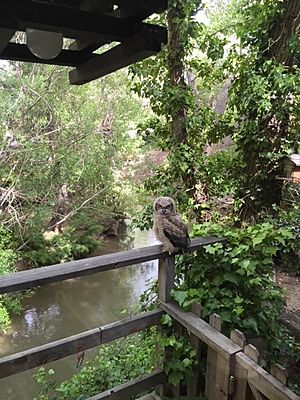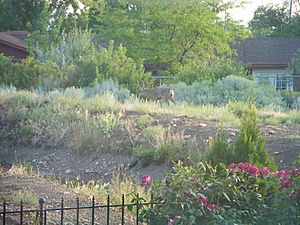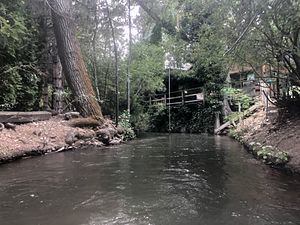Steamboat Ditch facts for kids
Quick facts for kids Steamboat Ditch |
|
|---|---|
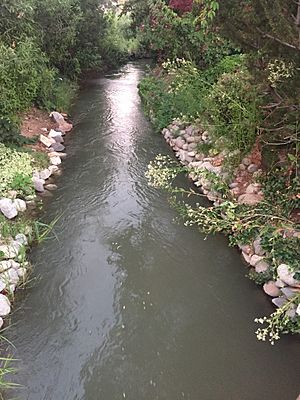 |
|
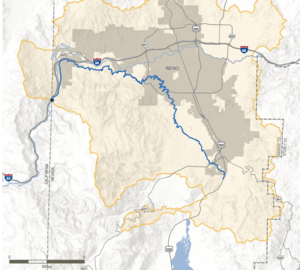
Map of the Steamboat Ditch
|
|
| Country | United States |
| State | Nevada |
| County | Washoe County, Nevada |
| Physical characteristics | |
| Length | 34 mi (55 km) |
The Steamboat Ditch is a long water channel, about 34 miles (55 km) in length. It was built in the late 1870s by Chinese workers. This important canal starts near the border of Nevada and California. It then flows into Steamboat Creek in the southern part of Reno. The ditch helps bring water to farms and other areas.
Contents
Where is the Steamboat Ditch Located?
This special water channel and the road next to it are mostly flat. The ground slopes gently downhill from where it starts. Most of the ditch is an open dirt channel. Different kinds of plants grow along its sides. The dirt road next to the canal is often called a "trail."
How the Steamboat Ditch Was Built
In 1877, a company called the Truckee & Steamboat Irrigating Canal Company decided to build the Steamboat Ditch. This project became the longest and most complex water channel in the area. Its total length is about 33 to 34 miles (53 to 55 km). Some older reports even say it was up to 48 miles (77 km) long!
The company hired 115 Chinese workers to build the ditch. They worked under European-American supervisors. A Chinese company from San Francisco, California, called Quong Yee Wo & Company, won the contract to build it for $36,000. Another report says a different San Francisco company, Lung Chung & Company, got the job.
By the next year, between 150 and 200 Chinese workers were on the job. The cost of building the ditch went up to $40,000. The work was tough, especially during the cold winter of 1878-1879. They even had to use dynamite in some places because the ground was frozen solid. The Steamboat Canal officially opened on July 1, 1880. Some records say the final cost was over $50,000.
A few years later, in 1885, the company that owned the ditch had money problems. Because of this, the ditch and its water rights were sold at an auction in 1886. John C. Hampton bought it for $15,750.
Who Owns the Ditch Today?
The Steamboat Ditch and its access road are owned by many different groups. These include private landowners, neighborhood groups, public utility companies, and even state, city, county, and federal governments. The Steamboat Canal & Irrigation Co. has a special right to use the ditch to move water for farming during the growing season.
Fun Things to Do at the Ditch
Many parts of the road next to the ditch have always been open to the public. This means they have become a popular walking and biking trail. It's like a long, green park in the city! People often use it for running, walking, riding bikes, walking their dogs, and watching birds every day. However, some parts of the trail are on private land, and those owners do not allow public access.
Animals and Plants Along the Ditch
Hundreds of different kinds of plants and animals live along the Steamboat Ditch trail. The ditch provides a very important water source during the dry summer months. This is especially true because the area is part of the Great Basin Desert, which is a very dry place.
Birds You Might See
- Mallard, Anas platyrhynchos
- Gadwall, Mareca strepera
- Song sparrow, Melospiza melodia
- Yellow-rumped warbler, Setophaga coronata
- Black-headed grosbeak, Pheucticus melanocephalus
- Black-chinned hummingbird, Archilochus alexandri
- Violet-green swallow, Tachycineta thalassina
- Tree swallow, Tachycineta bicolor
- Yellow warbler, Setophaga petechia
- Bullock's oriole, Icterus galbula
- Red-winged blackbird, Agelaius phoeniceus
- Western tanager, Piranga ludoviciana
- Wilson's warbler, Cardellina pusilla
- Cliff swallow, Petrochelidon pyrrhonota
- Hermit thrush, Catharus guttatus
- Belted kingfisher, Megaceryle alcyon
- Bewick's wren, Thryomanes bewickii
- Black-billed magpie, Pica hudsonia
- Cedar waxwing, Bombycilla cedrorum
- Bushtit, Psaltriparus minimus
- California quail, Callipepla californica
- White-crowned sparrow, Zonotrichia leucophrys
- Golden-crowned sparrow, Zonotrichia atricapilla
- Dark-eyed junco, Junco hyemalis
- Mountain chickadee, Poecile gambeli
- Townsend's solitaire, Myadestes townsendi
- Spotted towhee, Pipilo maculatus
- American robin, Turdus migratorius
- California scrub jay, Aphelocoma californica
- Common raven, Corvus corax
- Great horned owl, Bubo virginianus
- Barn owl, Tyto alba
- Cooper's hawk, Accipiter cooperii
- Sharp-shinned hawk, Accipiter striatus
- Rufous hummingbird, Selasphorus rufus
- Anna's hummingbird, Calypte anna
- Broad-tailed hummingbird, Selasphorus platycercus
- Orange-crowned warbler, Leiothlypis celata
- Barn swallow, Hirundo rustica
- Red-tailed hawk, Buteo jamaicensis
- Northern flicker, Colaptes auratus
- House wren, Troglodytes aedon
- Lesser goldfinch, Spinus psaltria
- American goldfinch, Spinus tristis
- Pine siskin, Spinus pinus
- Ruby-crowned kinglet, Regulus calendula
- Steller's jay, Cyanocitta stelleri
- American kestrel, Falco sparverius
- Peregrine falcon, Falco peregrinus
- Merlin, Falco columbarius
- Red-breasted sapsucker, Sphyrapicus ruber
- Red-naped sapsucker, Sphyrapicus nuchalis
- Mourning dove, Zenaida macroura
- Eurasian collared dove, Streptopelia decaocto
- House finch, Haemorhous mexicanus
- Cassin's finch, Haemorhous cassinii
- Downy woodpecker, Picoides pubescens
- Red breasted nuthatch, Sitta canadensis
- Say's phoebe, Sayornis saya
- Brewer's blackbird, Euphagus cyanocephalus
- Northern mockingbird, Mimus polyglottos
- European starling, Sturnus vulgaris
Butterflies You Might See
- Sylvan hairstreak, Satyrium sylvinum
- Behr's hairstreak, Satyrium behrii
- Juniper hairstreak, Callophrys gryneus
- Lorquin's admiral, Limenitis lorquini
- Monarch butterfly, Danaus plexippus
- Mourning cloak butterfly, Nymphalis antiopa
- Western tiger swallowtail, Papilio rutulus
- Mylitta crescent, Phyciodes mylitta
- Common checkered skipper, Pyrgus communis
- Gray hairstreak, Strymon melinus
- Pygmy blue butterfly, Brephidium exile
- Orange sulfur butterfly, Colias eurytheme
- Woodland skipper, Ochlodes sylvanoides
- Great Basin wood-nymph, Cercyonis sthenele
- Fiery skipper, Hylephila phyleus
- Sachem skipper, Atalopedes campestris
- Cabbage white butterfly, Pieris rapae
- California tortoiseshell, Nymphalis californica
- Painted lady butterfly, Vanessa cardui
Bees and Other Insects
- Mining bees, Andrena
- Blue milkweed beetle, Chrysochus cobaltinus
- Milkweed beetles, Tetraopes
- Long horned bees, Melissodes
- Bumblebees, Bombus
- Honeybees, Apis mellifera
- Convergent ladybug, Hippodamia convergens
Reptiles and Amphibians
- Sierra chorus frog, Pseudacris sierra
- Terrestrial garter snake, Thamnophis elegans
- Western fence lizard, Sceloporus occidentalis
- North American racer, Coluber constrictor
- Gopher snake, Pituophis catenifer
- Rubber boa, Charina bottae
- Western toad, Bufo boreas
Mammals You Might Spot
- Montane vole, Microtus montanus
- Coyote, Canis latrans
- Bobcat, Lynx rufus
- Black bear, Ursus americanus
- Mule deer, Odocoileus hemionus
- California ground squirrel, Otospermophilus beecheyi
- Grey squirrel, Sciurus griseus
- Least chipmunk, Tamias minimus
- American deer mouse, Peromyscus maniculatus
- Desert woodrat, Neotoma lepida
- Desert cottontail, Sylvilagus audubonii
Trees and Shrubs
- Fremont cottonwood, Populus fremontii
- Mountain alder, Alnus incana subsp. tenuifolia
- Coyote willow, Salix exigua
- Yellow willow, Salix lutea
- Wood's rose, Rosa woodsii
- California mugwort, Artemisia douglasiana
- Common mugwort, Artemisia ludoviciana
- Chokecherry, Prunus virginiana
- Jeffrey pine, Pinus jeffreyi
- Curl-leaf mountain mahogany, Cercocarpus ledifolius
- Antelope bitterbrush, Purshia tridentata
- Desert peach, Prunus andersonii
- Pinyon pine, Pinus monophylla
- Green ephedra, Ephedra viridis
- Wyoming sagebrush, Artemisia tridentata var. wyomingensis
- Rubber rabbitbrush, Ericameria nauseosa
Wildflowers and Grasses
- Narrowleaf milkweed, Asclepias fascicularis
- Showy milkweed, Asclepias speciosa
- Soft rush, Juncus effusus
- Baltic rush, Juncus balticus
- Bulrush, Scirpus
- Hooker's evening primrose, Oenothera elata
- Velvety goldenrod, Solidago velutina
- Western goldenrod, Solidago lepida
- Western goldentop, Euthamia occidentalis
- Creeping wildrye, Leymus triticoides
- Smoothstem blazingstar, Mentzelia laevicaulis
- Daggerpod, Phoenicaulis cheiranthoides
- Woolypod milkvetch, Astragalus purshii
- Nevada pea, Lathyrus lanszwertii
- Palmer's penstemon, Penstemon palmeri
- Roezeli's penstemon, Penstemon roezlii
- Prickly poppy, Argemone munita
- Dusty maiden, Chaenactis douglasii
- Great Basin wild rye, Leymus cinereus
- Squirrel tail, Elymus elymoides
- Veatches' blazingstar, Mentzelia veatchina
- Indian rice grass, Achnatherum hymenoides



